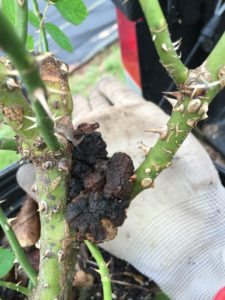COMMON NAME: Bacterial Crown Gall
SCIENTIFIC NAME: Agrobacterium tumefaciens (Pathogen)/ Rosa spp. (Host)
DISEASE DESCRIPTION
SYMPTOMS:
- Small, light green spherical swelling around the crown (or other infection sites) of the plant. The crown gall growth is different from the normal callus growths that commonly form at wound and grafting sites.
- Once the infection worsens, the shape of the galls becomes uneven, and they harden into a dark, woody mass.
- In heavily infected plants, secondary tumors may develop near the first gall.
- There may be several tumors affecting a single plant in any given infection.
Other symptoms induced by gall formation:
- Weakness
- Stunting
- Discoloration of leaves
- Dieback of shoots
- Increased susceptibility to winter injury or secondary infection
- Wilt and, eventually in severe infections, death
BIOLOGY:
Basic characteristics: Agrobacterium tumefaciens is a rhizoplane bacterium that lives in the soil. The pathogen grows as a gram-negative, strictly aerobic, bacilliform rods 1 x 3 µm, without any special nutrient requirements. The rods bear flagella that are arranged subpolarly around the cylindrical circumference of the cell, referred as circumthecal flagellation (see Figure below). This bacterium can survive in the free-living state in many soils with good aeration such as sandy loams where crown gall diseased plants have grown. The bacterium can also survive on the surface of roots (rhizoplane) of many orchard weeds.
Attack Mechanism: When A. tumefaciens cells perceive plant phenolic compounds usually produced at a wound site, the virulence genes (VirA/VirG) that are located in the resident Ti (tumor-inducing) plasmid are expressed, resulting in the formation of a long flexuous filament called the T pilus. The activation of VirA also shuts off motility of the circumthecal flagella, presumably when A. tumefaciens cells attach to plant cells. Attachment to the plant cells is a prerequisite for initiating the transfer of the T-DNA into the plant cell. Both the circumthecal flagella and the T pilus play an essential role in virulence, presumably by bringing the bacterial cell to its target followed by attachment to the plant host, respectively.
MANAGEMENT METHODS:
- Disease-free stocks: Purchase healthy plants. Avoid injuring the plant (especially around the roots and crown) while planting, and try to reduce the impact of chewing insects that can cause wounds.
- Site selection: Plant in soils with no previous record of crown gall. Fields that have grown cereal crops for a long period are favored as crown gall-free sites. Fields previously used for growing fruit and nut crops can remain infested with tumefaciens. Certain weeds such as morning glory (Ipomoea leptphylla) can serve as natural hosts of A. tumefaciensand therefore perpetuate the survival of this pathogen in field soils.
- Crop rotation:A crop rotation program employing cereal crops followed by green manuring helps reduce the population size of tumefaciens.
- Sanitation: Sterilize all pruning utensils before and after use. If symptoms develop after planting, dig up the whole plant and dispose of it properly, including the surrounding soil.
- Chemical control: Chemicals are rarely used for control of crown gall. However, there are some chemical control for the crown gall, particularly in production greenhouses and nurseries. Use insecticides to reduce the wounds on plant tissues that insects can cause. Use chemical eradicant of crown gall with creosote-based compounds, copper-based solutions, and strong oxidants such as sodium hypochlorite to control the disease. The chemical eradicant application procedure is labor intensive and therefore costly both monetarily and to the environment. The superficial treatments are ineffective against systemically infected plants.
- Biological control:Certain strains of tumefaciens are sensitive to the antibiotic agrocin produced by A. radiobacter, a closely related soil-borne bacterium that does not infect plants. Soak seeds or bare-rooted plants in a solution containing Agrobacterium radiobacter, as a preventive treatment. The bacterium A. radiobacter does not induce disease in plants. A. radiobacter uses similar resources and can prevent crown gall disease by typically out-competing A. tumefaciens.
- Genetically engineering: Transgenic crop plants harboring one or more unique genes tailored to protect the plant from crown gall have been developed. Genes encoding products that degrade or inactivate the T-DNA strand complex when it enters the host cell, that prevent the expression of T-DNA genes encoding indoleacetic acid and cytokinin biosynthesis, and that prevent tumefaciensattachment to its target are some examples currently being tested. Biotechnology companies, such as DNA Plant Technology
(Oakland, CA), are applying sense strand messenger RNA or small-interfering RNAs to develop crown gall resistant fruit and nut crops.
RESOURCE LINKS*:
– https://agrilifeextension.tamu.edu/library/landscaping/crown-gall-of-roses/ (Symptom & Management)
– https://www.apsnet.org/edcenter/disandpath/prokaryote/pdlessons/Pages/CrownGall.aspx Kado, C.I. 2002. Crown gall. The Plant Health Instructor. DOI:10.1094/PHI-I-2002-1118-01 (Symptoms and Biology)
This factsheet is authored by
Ping Yu
pursuing a PhD. in Horticulture
Factsheet information for the plant health issues represented by the images on the 2020 TPDDL calendar were written by graduate students enrolled in the Department of Plant Pathology & Microbiology DR. DAVID APPEL’s Graduate level Introductory Plant Pathology course (PLPA601) in the 2019 Fall semester. This exercise provides an opportunity for a high impact learning activity where the students are tasked with producing an informational output directed to the general public. This activity provides an opportunity for the students to write and produce a (hopefully) useful product to communicate information on plant health issues to the public.
